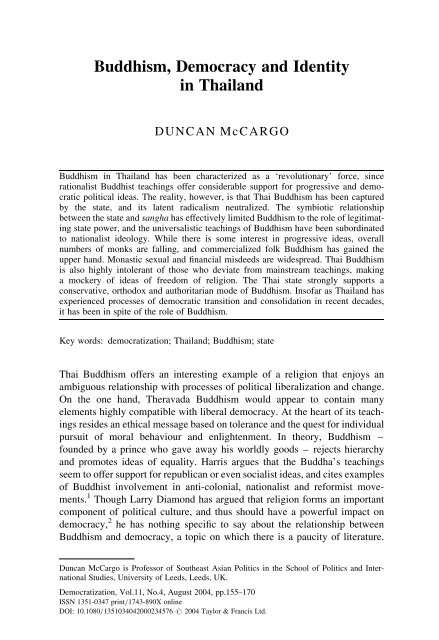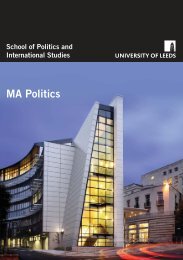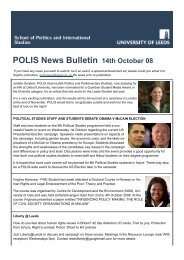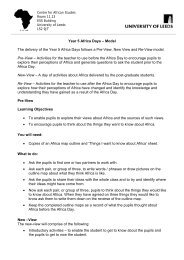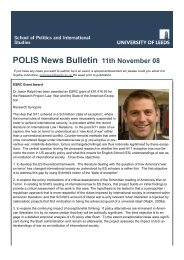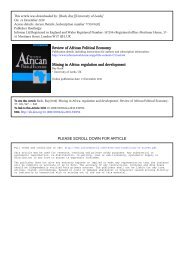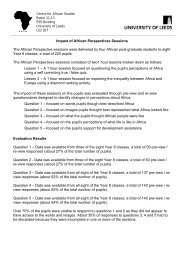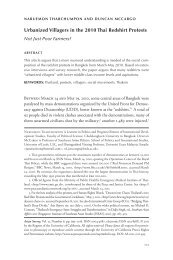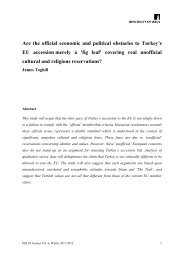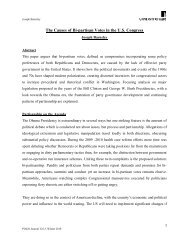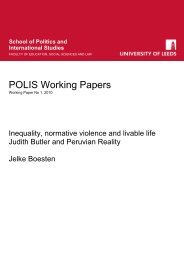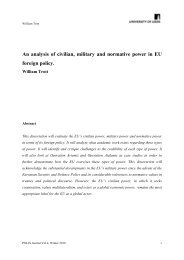Buddhism, Democracy and Identity in Thailand - Taylor & Francis ...
Buddhism, Democracy and Identity in Thailand - Taylor & Francis ...
Buddhism, Democracy and Identity in Thailand - Taylor & Francis ...
- No tags were found...
You also want an ePaper? Increase the reach of your titles
YUMPU automatically turns print PDFs into web optimized ePapers that Google loves.
BUDDHISM, DEMOCRACY AND IDENTITY IN THAILAND 157Underst<strong>and</strong><strong>in</strong>g the special relationship between the Buddhist <strong>and</strong> politicalorders <strong>in</strong> Thail<strong>and</strong> requires some familiarity with Thai historiography.Thail<strong>and</strong> is generally considered ‘unique’ <strong>in</strong> Southeast Asia, <strong>in</strong> that it wasnever formally colonized by western powers. Most scholars, both Thai <strong>and</strong>non-Thai, have seen Thail<strong>and</strong>’s non-colonization as a bless<strong>in</strong>g made possibleby the diplomatic skills of Siam’s n<strong>in</strong>eteenth-century k<strong>in</strong>gs. More criticalscholars, led by Benedict Anderson, have suggested that Siam was <strong>in</strong> fact<strong>in</strong>formally colonized, that the lack of a colonial experience <strong>in</strong>hibited theemergence of a genu<strong>in</strong>e nationalist movement <strong>in</strong> the country, <strong>and</strong> this led<strong>in</strong> turn to an immature <strong>and</strong> unstable political order. 9 Anderson suggests thatthe k<strong>in</strong>d of modernization carried out by the Chakri k<strong>in</strong>gs was analogousto that pursued by colonial governors under formal imperialism. In thissense, the <strong>in</strong>corporation of the Buddhist sangha <strong>in</strong>to a political order organizedalong pr<strong>in</strong>ciples of <strong>in</strong>ternal colonialism is an important element of thelegacy of the absolute monarchy. A new political order was ushered <strong>in</strong> bythe 1932 events which ended the absolute monarchy, but the country wasleft with a ‘modernized’ (<strong>in</strong> other words, a subord<strong>in</strong>ated <strong>and</strong> captured)Buddhist sangha. From 1932 to 1973, Thail<strong>and</strong> alternated between longspells of military rule <strong>and</strong> brief outbursts of electoral politics, <strong>in</strong> a politicalorder dom<strong>in</strong>ated by uniformed <strong>and</strong> civilian bureaucrats. 10 1973 saw apopular upris<strong>in</strong>g aga<strong>in</strong>st the military dictatorship of the time <strong>and</strong>, althoughthe nascent radical student movement was violently repressed three yearslater, the Thai political order had been permanently changed. Thai politicssaw major challenges to authoritarianism <strong>in</strong> the 1970s, symbolized most explicitlyby the student-led mass movement of October 1973, which culm<strong>in</strong>ated <strong>in</strong>the ouster of a military government <strong>and</strong> the beg<strong>in</strong>n<strong>in</strong>g of a more open period ofpolitics. Follow<strong>in</strong>g the repressive bloodshed of October 1976, the 1980s <strong>and</strong>1990s saw the gradual <strong>in</strong>stitutionalization of electoral politics – despitesuch setbacks as the 1991 military coup <strong>and</strong> the 1992 shoot<strong>in</strong>g dead ofpro-democracy demonstrators. Thai <strong>Buddhism</strong> rema<strong>in</strong>s to a significantextent enmeshed <strong>in</strong> an earlier set of political structures, immune from theemergence of much more plural <strong>and</strong> liberal politics s<strong>in</strong>ce the 1970s. Thisreflects the role of the Buddhist order as the h<strong>and</strong>maiden of the Thai state.Despite the elaborate formal structures of the Thai sangha, the <strong>in</strong>stitutionis not nearly so monolithic as it might first appear. In practice, <strong>in</strong>dividualmonks <strong>and</strong> abbots have considerable freedom of operation. By no means allmonks are state-oriented: a significant proportion are society-oriented activists,work<strong>in</strong>g <strong>in</strong> fields such as community development, traditional medic<strong>in</strong>e,conservation <strong>and</strong> moral education. There is also a strong tradition of forestmonks, dedicated to meditation <strong>and</strong> eschew<strong>in</strong>g the trapp<strong>in</strong>gs of modernity. 11Yet as a whole, the Thai Buddhist sangha has proved <strong>in</strong>capable of respond<strong>in</strong>geffectively to the chang<strong>in</strong>g nature of Thail<strong>and</strong>’s society <strong>and</strong> economy.
158 DEMOCRATIZATIONThe general direction of Thai politics from 1973 onwards was towards greaterpluralism <strong>and</strong> liberalism, but Buddhist th<strong>in</strong>k<strong>in</strong>g played a surpris<strong>in</strong>gly smallrole <strong>in</strong> these developments, most of which occurred with little <strong>in</strong>put fromthe orthodox sangha. Certa<strong>in</strong>ly, monks were not permitted to participate <strong>in</strong>radical protests or overt criticism of the political order – when a few tried,they were excoriated by the authorities. By contrast, monastic support for conservativecauses went unchallenged, most notoriously when the outspokenright-w<strong>in</strong>g monk Kittiwutto declared that ‘kill<strong>in</strong>g communists is not a s<strong>in</strong>’.This position reflected the extent to which Buddhist monks were themselvespart of the military-bureaucratic establishment. Anyth<strong>in</strong>g that underm<strong>in</strong>edthe dom<strong>in</strong>ance of the exist<strong>in</strong>g order would eventually lead to a question<strong>in</strong>gof the position of the sangha, <strong>and</strong> especially the privileged position ofsenior monks with<strong>in</strong> the sangha, who formed an unaccountable gerontocracy.The sangha faced numerous f<strong>in</strong>ancial <strong>and</strong> other sc<strong>and</strong>als <strong>in</strong> the 1980s <strong>and</strong>1990s, rang<strong>in</strong>g from a scam concern<strong>in</strong>g royal decorations (temple benefactorswho gave substantial donations were able to receive royal decorations, but <strong>in</strong>practice some monks were amenable to nom<strong>in</strong>at<strong>in</strong>g people for less than thego<strong>in</strong>g rate) to sexual sc<strong>and</strong>als <strong>in</strong>volv<strong>in</strong>g the ‘superstar’ monk Phra Yantra, acharismatic preacher who fell from grace <strong>in</strong> 1995 <strong>and</strong> eventually fled to theUnited States. The overall picture was one of an ill-discipl<strong>in</strong>ed sangha, s<strong>in</strong>gularlyfail<strong>in</strong>g to renew itself <strong>and</strong> re<strong>in</strong>vigorate Thai <strong>Buddhism</strong>. It was alsoa sangha ill-equipped to flourish <strong>in</strong> a more open political order, with abroader civil society. Much of the community role previously assumed bymonks was now assumed by a range of governmental <strong>and</strong> non-governmentalorganizations, while a vociferous mass media scrut<strong>in</strong>ized the affairs oftemples much more closely than before.In earlier centuries <strong>and</strong> decades, temples had offered an attractive opportunityto young men, especially those from poor backgrounds. Through themonastic system, men could ga<strong>in</strong> a free education <strong>and</strong> a good st<strong>and</strong>ard ofliv<strong>in</strong>g. It is no secret that Thai monks, though theoretically forbidden toh<strong>and</strong>le cash, actually receive significant <strong>in</strong>comes from the services theyoffer (rang<strong>in</strong>g from bless<strong>in</strong>g people, houses, cars <strong>and</strong> shops to suggest<strong>in</strong>gnumbers likely to w<strong>in</strong> the lottery, <strong>and</strong> sell<strong>in</strong>g holy amulets). This <strong>in</strong>come iscrucial as an <strong>in</strong>centive for monastic recruitment, but can also serve todistort the priorities <strong>and</strong> activities of monks, contribut<strong>in</strong>g to widespreaddiscipl<strong>in</strong>ary lapses. In 2000, a television station screened footage of a monk‘dressed <strong>in</strong> a military uniform with girls on his arm, driv<strong>in</strong>g a luxuryMercedes-Benz <strong>and</strong> resid<strong>in</strong>g <strong>in</strong> a house’. 12 In 2001, Manop Polpar<strong>in</strong> of thegovernment’s Religious Affairs Department declared that as many as one <strong>in</strong>ten Thai monks <strong>and</strong> novices were drug addicts – a problem most abbotssought to deny existed. 13 By the beg<strong>in</strong>n<strong>in</strong>g of the twenty-first century, thenumbers of monks <strong>in</strong> Thai temples had slumped alarm<strong>in</strong>gly; many rural
BUDDHISM, DEMOCRACY AND IDENTITY IN THAILAND 159temples had only one or two permanent resident monks, <strong>in</strong>creased by a smallnumber of temporary ord<strong>in</strong>ees dur<strong>in</strong>g the ra<strong>in</strong>y season. Young men <strong>in</strong> ruralareas had a range of other options apart from enter<strong>in</strong>g the monkhood,especially the opportunity to work <strong>in</strong> Bangkok <strong>in</strong> the <strong>in</strong>dustrial or servicesectors. Education could be ga<strong>in</strong>ed through other routes, too, <strong>and</strong> monasticqualifications – based largely on memoriz<strong>in</strong>g Pali texts – were decl<strong>in</strong><strong>in</strong>g <strong>in</strong>attractiveness to employers. At the same time, the decl<strong>in</strong>e <strong>in</strong> permanent populationsof lay villagers underm<strong>in</strong>ed the viability of rural temples. Because Thaitemples rely on local villagers to feed their monks, villagers whose populationsare depleted by large numbers of people work<strong>in</strong>g away from homef<strong>in</strong>d it difficult to support sizeable monastic communities. The centralsangha does not fund or subsidize rural temples, <strong>and</strong> there are huge disparities<strong>in</strong> <strong>in</strong>come between rural temples <strong>and</strong> the major urban temples, especially those<strong>in</strong> Bangkok. The ma<strong>in</strong> difference between Theravada <strong>Buddhism</strong> <strong>and</strong> othermajor world religions is the very high ratio of orda<strong>in</strong>ed to lay participants;ma<strong>in</strong>ta<strong>in</strong><strong>in</strong>g this ratio is possible <strong>in</strong> relatively affluent <strong>and</strong> pious communities,but becomes <strong>in</strong>creas<strong>in</strong>gly difficult when levels of affluence or religiositydecl<strong>in</strong>e. Sc<strong>and</strong>als <strong>in</strong>volv<strong>in</strong>g the sangha have underm<strong>in</strong>ed public confidence<strong>and</strong> reduced levels of religious participation. Thus orthodox Theravada <strong>Buddhism</strong>is com<strong>in</strong>g under susta<strong>in</strong>ed pressure, a pressure which ill equips it toform the basis of a religious, national or collective identity for Thai people.The loud criticisms of the Thai Buddhist order currently be<strong>in</strong>g voicedcontribute to a defensive, siege mentality among the sangha leadership.Well-known historian Nithi Aeusriwongse has argued that the sangha is <strong>in</strong>dire need of extensive structural reform. 14 He has called for a return to the traditionalstatus of temples as educational centres for the community, run withthe active participation of local people. In other words, he argues that<strong>Buddhism</strong> <strong>in</strong> Thail<strong>and</strong> can only be revitalized by sever<strong>in</strong>g the <strong>in</strong>timatebonds between sangha <strong>and</strong> state created dur<strong>in</strong>g the reign of K<strong>in</strong>g Chulalongkorn(1868–1910), when <strong>Buddhism</strong> was bureaucratized <strong>and</strong> thoroughlysubord<strong>in</strong>ated to the nation-build<strong>in</strong>g project of the state. However, no recentThai government has shown any enthusiasm for legislative reform of thesangha through repeal of the 1962 Sangha Act. Any such reform would triggera backlash from conservative forces, which would denounce changes as politicallymotivated attempts to underm<strong>in</strong>e one of the nation’s highest <strong>in</strong>stitutions.Particularism <strong>and</strong> Universalism <strong>in</strong> Recent Thai Buddhist ThoughtFor the moment, <strong>Buddhism</strong> <strong>in</strong> Thail<strong>and</strong> rema<strong>in</strong>s an essentially domestic affair.At an official level, there are very few contacts between the Buddhist sanghasof ma<strong>in</strong>l<strong>and</strong> Southeast Asia. For the most part, Thai, Lao, Cambodian <strong>and</strong>Burmese monks do not visit each other’s countries. Exceptions <strong>in</strong>clude a
160 DEMOCRATIZATIONfew Thai monks who have personal ties with Burmese counterparts go<strong>in</strong>g backdecades, <strong>and</strong> some Lao monks stay<strong>in</strong>g at temples <strong>in</strong> northeast Thail<strong>and</strong>, oftenfor purposes of study. When a delegation of n<strong>in</strong>e Thai monks went to Laos <strong>in</strong>1989 (the first such delegation s<strong>in</strong>ce 1975), their trip <strong>in</strong>voked the ire of theThai military, who regarded their visit as a threat to national security. Regionalgather<strong>in</strong>gs of Buddhist clergy tend to be sponsored by <strong>in</strong>ternational organizationsfor the discussion of social issues, rather than purely religious questions.Such gather<strong>in</strong>gs, however, <strong>in</strong>volve only those relatively small sectionsof the Thai sangha that are socially activist <strong>and</strong> <strong>in</strong>ternationalist <strong>in</strong> outlook.The sangha hierarchy often views meet<strong>in</strong>g of this k<strong>in</strong>d with suspicion,especially when they <strong>in</strong>volve Japanese, Ch<strong>in</strong>ese, Korean or Vietnamesemonks from the Mahayana tradition.<strong>Buddhism</strong> has long been a source of identity for Thai people, rather than auniversalistic religion. In this respect, Mahayana <strong>Buddhism</strong> – which supportsthe idea of an East Asian commonality – differs from the particularistic Theravadatradition. Suwanna sees the late scholar-monk Buddhadasa Bhikkhu asthe only genu<strong>in</strong>ely universalistic th<strong>in</strong>ker <strong>in</strong> recent Thai <strong>Buddhism</strong>, st<strong>and</strong><strong>in</strong>gout aga<strong>in</strong>st the dom<strong>in</strong>ant tendencies of particularism. 15 Buddhadasa (1906–1993) was the lead<strong>in</strong>g Thai Buddhist th<strong>in</strong>ker of the twentieth century, a prolificwriter <strong>and</strong> preacher who spent much of his life at Suan Mokh, a forestmonastery he founded <strong>in</strong> the southern prov<strong>in</strong>ce of Surat Thani. Buddhadasa’swrit<strong>in</strong>gs have been immensely <strong>in</strong>fluential, both <strong>in</strong>side <strong>and</strong> outside Thail<strong>and</strong>.One of his ma<strong>in</strong> themes is the need to separate the core of Buddhist teach<strong>in</strong>gs(dharma) from superstitious accretions, such as the widespread popular preoccupationwith fate (kharma). Suwanna def<strong>in</strong>es Buddhadasa core <strong>in</strong>tellectualproject thus: how can Thai <strong>Buddhism</strong> be liberated from Thai popularculture? <strong>Buddhism</strong> needs to be liberated from its cultural constra<strong>in</strong>ts beforeuniversalism becomes possible. Universalism opens up <strong>Buddhism</strong> to all,<strong>in</strong>clud<strong>in</strong>g those <strong>in</strong> the West. But it ascribes no special significance to Asia;nowhere <strong>in</strong> this writ<strong>in</strong>gs does Buddhadasa discuss the concept of Asia, oran Asian Buddhist identity. Suwanna regards <strong>Buddhism</strong> as a universalistreligion which has been improperly comm<strong>and</strong>eered by particular states <strong>and</strong>cultures to legitimate themselves.S<strong>in</strong>ce the death of Buddhadasa, Pra Dhammadipok (Prayudh Payutto)has assumed the mantle of the pre-em<strong>in</strong>ent scholar-monk of Thail<strong>and</strong>.Dhammadipok (who won the UNESCO prize for peace education <strong>in</strong> 1994)is much more of an establishment figure than Phuttathat, <strong>and</strong> one with aless universalistic outlook. Many of Dhammadipok’s books conta<strong>in</strong> theword ‘Thai’ <strong>in</strong> their titles, <strong>and</strong> explicitly contrast the positive aspects ofThai <strong>Buddhism</strong> with negative features of other cultures, especially westernculture. Examples <strong>in</strong>clude his well-known Look<strong>in</strong>g to America to SolveThail<strong>and</strong>’s Problems, 16 <strong>and</strong> more recent volumes <strong>in</strong>clud<strong>in</strong>g Thail<strong>and</strong> Will
BUDDHISM, DEMOCRACY AND IDENTITY IN THAILAND 161Be <strong>in</strong> Crisis if Thais Have Unnatural Faith, Look<strong>in</strong>g for Thai Culture Based onTrue Education, <strong>and</strong> Love: from Valent<strong>in</strong>e to Thai-ness. 17 All thesebooks stress the degree to which Thais are <strong>in</strong> danger of los<strong>in</strong>g sight of their<strong>in</strong>digenous cultural <strong>and</strong> religious values.In recent years, Thai claims of a culturally dist<strong>in</strong>ctive national identityhave been challenged by the discourse of bus<strong>in</strong>ess <strong>and</strong> management studies.The popularity of books by bus<strong>in</strong>ess gurus <strong>and</strong> futurologists such as TomPeters, Alv<strong>in</strong> Toffler <strong>and</strong> John Naisbitt (many of which have been bestsellers<strong>in</strong> Thai translation) has given rise to an alternative ‘universalism’ predicatedupon the philosophy of the market. Phra Dhammapidok has criticizedthe fashion for the concepts of ‘globalization’ <strong>and</strong> ‘reeng<strong>in</strong>eer<strong>in</strong>g’ <strong>in</strong>Thail<strong>and</strong>. 18 These terms have become extremely pervasive <strong>in</strong> populardiscourse, as well as constant reference po<strong>in</strong>ts <strong>in</strong> academic <strong>and</strong> bus<strong>in</strong>esscircles. Dhammapidok has argued that negative aspects of globalization,such as environmental degradation, <strong>in</strong>tense bus<strong>in</strong>ess competition, <strong>and</strong> thequest for personal advantage, has overshadowed the positive aspects stressedby most commentators. He has been similarly critical of the concept ofre-eng<strong>in</strong>eer<strong>in</strong>g, which he argued was aimed simply at <strong>in</strong>tensify<strong>in</strong>g the levelof competition <strong>in</strong> bus<strong>in</strong>ess. He argued that western civilization was fundamentallyflawed <strong>in</strong> its view (derived from Greek civilization) that man is superiorto nature, a misunderst<strong>and</strong><strong>in</strong>g which had led to environmental destruction <strong>and</strong>human suffer<strong>in</strong>g. 19 He was concerned to defend the particularist religiousdiscourse of Thai <strong>Buddhism</strong> aga<strong>in</strong>st the quasi-universal, secular threatposed by western bus<strong>in</strong>ess culture. Thus he argued on two fronts, reject<strong>in</strong>gboth secularism <strong>and</strong> cultural homogenization. Dhammadipok’s th<strong>in</strong>k<strong>in</strong>gillustrates precisely the limited engagement of ma<strong>in</strong>stream Thai Buddhistth<strong>in</strong>k<strong>in</strong>g with ideas of liberalism. The pr<strong>in</strong>ciples he advocated were consistentlytied to a conservative, nationalist agenda, represent<strong>in</strong>g the respectable<strong>and</strong> articulate voice of the orthodox sangha.Sulak Sivaraksa: Conservative RadicalismOne outst<strong>and</strong><strong>in</strong>g figure who has attempted to promote an <strong>in</strong>ternationalist,universalist <strong>Buddhism</strong> is the prom<strong>in</strong>ent social critic <strong>and</strong> <strong>in</strong>tellectual SulakSivaraksa. Ironically, however, Sulak’s <strong>in</strong>ternationalism is based upon ideasof cultural nationalism. When Sulak <strong>and</strong> like-m<strong>in</strong>ded <strong>in</strong>tellectuals challengethe orthodox l<strong>in</strong>kage between official <strong>Buddhism</strong> <strong>and</strong> the Thai state, theyemploy what Thongchai called a ‘conservative radical’ or a ‘Buddhistradical’ argument. 20 That is, they argue for a different def<strong>in</strong>ition of ‘Tha<strong>in</strong>ess’from that advocated by conservative nationalists. ‘Tha<strong>in</strong>ess’ for them consistsof <strong>in</strong>digenous pr<strong>in</strong>ciples of Thai Buddhist culture, which have been distorted<strong>and</strong> misrepresented by the orthodoxies of the state. Nevertheless, this read<strong>in</strong>g
162 DEMOCRATIZATIONof Thai <strong>Buddhism</strong> is of a cultural nationalist character, rather than either a universalist<strong>in</strong>terpretation, or one based on a sense of shared Asian identity. AsThongchai notes, this ‘radical Buddhist’ view of Tha<strong>in</strong>ess is predicatedupon a sense of threat, a feel<strong>in</strong>g that Thai identity is endangered by the pervasivedom<strong>in</strong>ance of western culture. Sulak, however, has sought to establishl<strong>in</strong>ks with other Buddhists through non-governmental organizations such asthe International Network of Engaged Buddhists <strong>and</strong> the Thai Inter-ReligiousCommission for Development. His writ<strong>in</strong>gs are pervaded with criticisms ofwestern <strong>in</strong>fluences <strong>and</strong> western consumerism, 21 a problematic argumentgiven that many consumer products sold <strong>in</strong> Thail<strong>and</strong> <strong>and</strong> other SoutheastAsian countries are of Japanese (<strong>and</strong> <strong>in</strong>creas<strong>in</strong>gly South Korean) design <strong>and</strong>orig<strong>in</strong>. Sulak’s ideas have s<strong>in</strong>gularly failed to ga<strong>in</strong> popular currency, <strong>in</strong>fluenc<strong>in</strong>gonly relatively narrow <strong>in</strong>tellectual circles. 22Despite the fact that he is first <strong>and</strong> foremost a cultural nationalist, Sulakhas the English skills <strong>and</strong> the <strong>in</strong>ternational connections to reach beyond Thail<strong>and</strong>.Interest<strong>in</strong>gly, Sulak began his career <strong>in</strong> just the opposite way, help<strong>in</strong>g to<strong>in</strong>troduce the pr<strong>in</strong>ciples of western social science to Thail<strong>and</strong> dur<strong>in</strong>g the1960s, <strong>and</strong> promot<strong>in</strong>g the translation of classic western texts <strong>in</strong>to Thai. Nowhe has diversified away from <strong>in</strong>tellectual import, <strong>and</strong> <strong>in</strong>to <strong>in</strong>tellectual <strong>and</strong>spiritual export. By do<strong>in</strong>g so, he is attempt<strong>in</strong>g to exp<strong>and</strong> the realm of Thaicultural values. In one 1995 <strong>in</strong>terview, Sulak lamented that Thail<strong>and</strong> hadthe potential to assume leadership of the <strong>in</strong>ternational Buddhist movement,but no one was <strong>in</strong>terested <strong>in</strong> tak<strong>in</strong>g on the challenge. 23 Sulak’s stanceillustrates a further dimension of Buddhist political discourse <strong>in</strong> Thail<strong>and</strong>:his criticisms of the orthodox sangha were always predicated on his deeplyroyalist conservatism. Ultimately, he is a product <strong>and</strong> admirer of the Thaiestablishment, rather than someone who has sought to subvert it.Thai-ness <strong>and</strong> ‘Radical Buddhist’ Political DiscourseAt the same time, elements of a ‘conservative radical Buddhist’ discourse haveproved politically popular at a more general level. One prom<strong>in</strong>ent politicianwho has exploited the appeal of a ‘radical Buddhist’ nationalist discourse <strong>in</strong>Thail<strong>and</strong> is the former Bangkok governor <strong>and</strong> Palang Dharma Party founderChamlong Srimuang. 24 Chamlong is a devoted member of the ascetic SantiAsoke Buddhist movement. Santi Asoke, led by the charismatic former televisionstar Photirak, has several thous<strong>and</strong> members across Thail<strong>and</strong>, many liv<strong>in</strong>g<strong>in</strong> model village communities, <strong>and</strong> adher<strong>in</strong>g to a strict code of behaviour.Photirak has been <strong>in</strong> conflict with the Thai government <strong>and</strong> the sangha authorities,which viewed Santi Asoke as a dissident movement; Photirak <strong>and</strong> hisfellow Santi Asoke monks were expelled from the sangha <strong>in</strong> 1988, <strong>and</strong> weresubsequently prosecuted for violations of religious law. Chamlong himself is
BUDDHISM, DEMOCRACY AND IDENTITY IN THAILAND 163famous for eat<strong>in</strong>g only one vegetarian meal a day, <strong>and</strong> hav<strong>in</strong>g taken a vow ofcelibacy. While advocat<strong>in</strong>g Thai values <strong>and</strong> behaviour, such as wear<strong>in</strong>g Thaiclothes <strong>and</strong> eat<strong>in</strong>g Thai fruits, he stresses that his approach is practical <strong>and</strong> unromantic:he wants to improve contemporary Thai society, rather than simplyrevert<strong>in</strong>g to the past. Nevertheless, Chamlong’s references to Tha<strong>in</strong>ess appearedlargely rhetorical, the conjur<strong>in</strong>g up of an edify<strong>in</strong>g mythical Thai village as anelectoral commodity to improve his political prospects. Chamlong won remarkablepolitical success <strong>in</strong> the Bangkok gubernatorial elections of 1985 <strong>and</strong> 1990,<strong>and</strong> his party briefly held almost every parliamentary seat <strong>in</strong> Bangkok follow<strong>in</strong>gthe March 1992 general election. Chamlong’s ability to consolidate his politicalcareer even after Santi Asoke was expelled from the sangha demonstrated thathe was not reliant on state approval; his electoral successes seemed to suggestthe emergence of a new mode of political populism, <strong>and</strong> certa<strong>in</strong>ly testified to theway <strong>in</strong> which the Bangkok electorate was will<strong>in</strong>g to back non-st<strong>and</strong>ard politicians.It was clear that the wider urban public was much more tolerant ofthe ‘dissident’ Santi Asoke than were bureaucrats <strong>and</strong> senior monks. At thesame time, Chamlong’s affiliations with the movement marked him down asa threat <strong>in</strong> the eyes of many conservatives. In May 1992, Chamlong becamethe lead<strong>in</strong>g figure <strong>in</strong> an extra-parliamentary movement to oust former coupleader General Such<strong>in</strong>da Kraprayoon from the premiership. The movement succeeded– though at least 44 people <strong>and</strong> probably twice that many were shot deadon the streets of Bangkok. Chamlong paid a heavy personal price for his actions;implicitly rebuked by the k<strong>in</strong>g as a trouble maker, his political career was effectivelyf<strong>in</strong>ished. While it is impossible to say exactly what part Chamlong’s religiousviews played <strong>in</strong> his political downfall, it seems likely that his Santi Asokeconnections meant he was never trusted <strong>in</strong> the palace. 25Chamlong never explicitly l<strong>in</strong>ked his Buddhist radicalism to a detailedpolitical programme, but his use of Buddhist radical discourse helped attractsupport from Bangkok voters disillusioned with the prevail<strong>in</strong>g politicalorder. Interviewed about questions such as ‘Buddhist economics’, Chamlonghimself waffled <strong>and</strong> his economist secretary-general dismissed the idea. 26Radical <strong>Buddhism</strong> was for them an image, rather than a set of policies.Dur<strong>in</strong>g the 1995 election, Chamlong’s Palang Dharma Party ran an extremelypopular television advertisement, featur<strong>in</strong>g scenes from an idealized versionof Thai village life. The advertisement illustrated Palang Dharma’s attemptsto project an image as an authentically Thai political party. The party collapsedpolitically soon after the 1996 general election, but ironically someof the ideas associated with Buddhist radicalism were popularized follow<strong>in</strong>gthe 1997 economic crisis. 27 In his birthday speech that year, the Thai k<strong>in</strong>gcalled for the creation of a ‘sufficiency economy’, 28 argu<strong>in</strong>g that the crisishad shown Thais the importance of self-reliance, susta<strong>in</strong>ability <strong>and</strong> th<strong>in</strong>k<strong>in</strong>gsmall. 29 Hewison has criticized such ideas for their romanticization of
164 DEMOCRATIZATIONvillage life, <strong>and</strong> implicit ‘Buddhist chauv<strong>in</strong>ism’, privileg<strong>in</strong>g Buddhist conceptionsof Thai culture <strong>and</strong> identity. In the aftermath of the crisis, SantiAsoke – which had long advocated certa<strong>in</strong> localist ideas – saw a surge <strong>in</strong><strong>in</strong>terest. 30In 2001, the new Thai government led by billionaire telecommunicationsmagnate Thaks<strong>in</strong> Sh<strong>in</strong>awatra adopted some of the rhetoric of Buddhist radicalnationalism, clearly seen <strong>in</strong> the name of his party: the Thais Love Thai Party(Thai Rak Thai). 31 Thaks<strong>in</strong> supported the idea of ‘one district, one product’, alocalist economic policy which had been imported from Japan, but resembledmany of Chamlong’s earlier pet projects. Chamlong was a close associate ofThaks<strong>in</strong>, who had taken over the leadership of Palang Dharma <strong>in</strong> an earlierpolitical <strong>in</strong>carnation. Santi Asoke ideas popularized by Chamlong had beenechoed by the k<strong>in</strong>g <strong>and</strong> were then picked up to promote a political party ledby the chief representative of Thail<strong>and</strong>’s nouveau riche. These apparentlybizarre borrow<strong>in</strong>gs <strong>and</strong> adaptations reflect the complexity of Thai politics <strong>in</strong>the early twenty-first century.Political Reform <strong>and</strong> Religious FreedomA l<strong>and</strong>mark <strong>in</strong> modern Thai politics was the new constitution of 1997, widelyhailed as a ‘peoples’ constitution’, <strong>and</strong> said by some to have ‘laid the basis forlong term emergence of Thai liberalism’. 32 An important feature of the 1997constitution was its emphasis on rights – <strong>in</strong>clud<strong>in</strong>g the creation of a humanrights commission, an entirely new <strong>in</strong>novation. Prawase Wasi, one of thearchitects of the constitution, came under considerable pressure from Buddhistgroups to make <strong>Buddhism</strong> the national religion, pressures which were ultimatelyresisted. 33 Like previous Thai constitutions (the 1997 constitutionwas Thail<strong>and</strong>’s 16th s<strong>in</strong>ce 1932), the 1997 constitution stated that all Thaishave the right to religious freedom. Indeed, it goes further than its two predecessors<strong>in</strong> stat<strong>in</strong>g that a person ‘shall enjoy full liberty to ...observe religiousprecepts’. 34 This covered activities related to religious belief, but not amount<strong>in</strong>gto acts of worship. But as Streckfuss <strong>and</strong> Templeton note, the provisions ofthe 1997 constitution offer less protection than those suggested by theInternational Covenant on Civil <strong>and</strong> Political Rights; <strong>in</strong> particular, they donot explicitly protect the freedom to adopt a different religion.Thail<strong>and</strong> is not a country characterized by serious religious persecution orovert bigotry, <strong>and</strong> most Thais would undoubtedly assert that they <strong>and</strong> theircompatriots enjoy full religious freedom. Nevertheless, there is substantialevidence to contradict this view, <strong>in</strong> the specific case of Buddhist groups ormovements whose teach<strong>in</strong>gs deviate from the l<strong>in</strong>es adopted by the statesanctionedsangha hierarchy. The best example concerns Wat Thammakai,a middle-class Buddhist movement centred on a large temple complex just
BUDDHISM, DEMOCRACY AND IDENTITY IN THAILAND 165north of Bangkok. The movement has long been associated with ambitiousbuild<strong>in</strong>g projects funded by sizeable donations solicited from followers –<strong>in</strong>clud<strong>in</strong>g members of many elite bus<strong>in</strong>ess, bureaucratic <strong>and</strong> political families –<strong>and</strong> for the unorthodox meditation techniques it advocates, promis<strong>in</strong>g a quickway to nirvana. 35 While another heterodox movement, Santi Asoke, wasousted from the orthodox sangha <strong>in</strong> the 1980s, Wat Thammakai flourishedunchecked for much longer, largely ow<strong>in</strong>g to ‘protection’ from wellconnectedsupporters. By 1999, however, Wat Thammakai was <strong>in</strong> disgrace,the abbot charged with various offences concern<strong>in</strong>g illegal l<strong>and</strong> purchases<strong>and</strong> embezzlement. These alleged crimes, however, were overshadowed byan outspoken public denunciation of the movement’s version of <strong>Buddhism</strong>,culm<strong>in</strong>at<strong>in</strong>g <strong>in</strong> the Supreme Sangha Council order<strong>in</strong>g the abbot to renouncehis teach<strong>in</strong>gs, <strong>and</strong> the Religious Affairs Department (part of the M<strong>in</strong>istry ofEducation) charg<strong>in</strong>g Wat Thammakai with ‘propagat<strong>in</strong>g false teach<strong>in</strong>gson Nirvana, caus<strong>in</strong>g divisiveness among monks, <strong>and</strong> spread<strong>in</strong>g hereticdoctr<strong>in</strong>es’. 36 However, as Streckfuss <strong>and</strong> Templeton observe, ‘heresy is nota crime, even <strong>in</strong> Thail<strong>and</strong>’. 37 In other words, there is a schizophrenicconfusion at the heart of Thai th<strong>in</strong>k<strong>in</strong>g about <strong>Buddhism</strong>. On the one h<strong>and</strong>,the constitution guarantees freedom of religion; on the other h<strong>and</strong>, the Thaisangha <strong>and</strong> state believe that, like the medieval Catholic church, theypossess the right to determ<strong>in</strong>e what does <strong>and</strong> does not amount to orthodox<strong>Buddhism</strong>. Under 1969 legislation, the Religious Affairs Department hasthe right to recognize new religious movements under certa<strong>in</strong> clearlydef<strong>in</strong>ed criteria, <strong>in</strong>clud<strong>in</strong>g their be<strong>in</strong>g non-political. For this reason, commentatorssuch as Stewart have suggested that freedom of religion simply does notexist <strong>in</strong> Thail<strong>and</strong>. 38 What is rather surpris<strong>in</strong>g is that despite the popular senseof rights <strong>and</strong> democratic ideas supposedly manifest <strong>in</strong> the 1997 constitutiondraft<strong>in</strong>gprocess, there has been remarkably little public debate aboutfreedom of religion as seen <strong>in</strong> the Wat Thammakai case. Practically no prom<strong>in</strong>entThai scholar or public figure spoke out openly <strong>in</strong> defence of themovement’s freedom to advocate divergent religious ideas; <strong>in</strong>deed, many<strong>in</strong>dividuals widely seen as liberal commentators expressed profoundlyilliberal views on the question of Wat Thammakai, frequently conflat<strong>in</strong>g crim<strong>in</strong>alcharges aga<strong>in</strong>st the abbot with criticisms of the movement’s Buddhistteach<strong>in</strong>gs. Even Santi Asoke, an organization that might be expected tosupport the pr<strong>in</strong>ciple of religious freedom, was quick to condemn WatThammakai. Santi Asoke’s chief adm<strong>in</strong>istrator expla<strong>in</strong>ed that Thammakai’smethods of solicit<strong>in</strong>g donations violated Buddhist doctr<strong>in</strong>es. 39This episode raises difficult questions about the degree to which democraticideas have been firmly <strong>in</strong>stitutionalized <strong>in</strong> the Thai political order.Criticis<strong>in</strong>g the sangha is a problematic act – Matichon, a lead<strong>in</strong>g Thai politicaldaily, had briefly to close itself down <strong>in</strong> 1991, <strong>in</strong> order to atone for hav<strong>in</strong>g
166 DEMOCRATIZATIONpublished a letter alleged to have defamed the Supreme Patriarch. 40 The veryfew Thai scholars who hold progressive views on this subject expla<strong>in</strong> privatelythat they are very reluctant to risk the backlash associated with publicly adopt<strong>in</strong>gcritical or liberal positions on issues relat<strong>in</strong>g to the Buddhist order. Farfrom be<strong>in</strong>g a religion particularly compatible with democratic ideas,<strong>Buddhism</strong> <strong>in</strong> the Thai context has become an authoritarian religion, <strong>in</strong>tolerantof dissent <strong>and</strong> unwill<strong>in</strong>g to accept critical voices. Indeed, the sangha hierarchyare complicit <strong>in</strong> creat<strong>in</strong>g a climate of fear that curtails serious <strong>in</strong>tellectualdebate about religious issues; they work closely with the state security apparatus.A critical report by the National Security Council was one of the developmentsthat culm<strong>in</strong>ated <strong>in</strong> the crackdown on Wat Thammakai. 41 Even thehead of the Law Society called for new procedures to expel heretical monksexpeditiously. 42 Some liberals proposed a ‘compromise’ solution, <strong>in</strong> whichWat Thammakai would be allowed to cont<strong>in</strong>ue its existence, but would notbe permitted to call itself a Theravada Buddhist organization. Such suggestionsillustrated a cont<strong>in</strong>u<strong>in</strong>g confusion about the mean<strong>in</strong>g of religiousfreedom: the state was seek<strong>in</strong>g to assign to itself, not only the right to ‘authorize’religious movements, but also to regulate the way those movementssought to designate themselves. A suggestion that Wat Thammakai supporterswere creat<strong>in</strong>g their own political party (the Thai Maharat Party) <strong>in</strong> order tocontest the 2001 general elections generated considerable criticism, <strong>and</strong>came to noth<strong>in</strong>g. 43 Ultimately, the Constitutional Court seemed likely to be<strong>in</strong>fluenced by the def<strong>in</strong>itions of ‘religious sect’ <strong>and</strong> creed’ enshr<strong>in</strong>ed <strong>in</strong> 1969legislation <strong>and</strong> policed by the Religious Affairs Department. Keyes hascited Thammakai as an example of Thail<strong>and</strong>’s Buddhist diversity, illustrat<strong>in</strong>gthe emergence of a ‘civic religion’ not determ<strong>in</strong>ed by the state; 44 Swearersimilarly argues that there is a ‘creative tension between the new movementsof the periphery <strong>and</strong> the civil religion of the centre’. 45 But Streckfuss <strong>and</strong>Templeton po<strong>in</strong>t out that such developments should not be taken to suggesta benignly pluralist religious outlook. Rather, they follow Stewart <strong>in</strong>suggest<strong>in</strong>g that Thail<strong>and</strong> has adopted a very conservative <strong>and</strong> highly orthodox<strong>Buddhism</strong> as a de facto state religion. 46Thai <strong>Buddhism</strong>, <strong>in</strong> other words, offers mislead<strong>in</strong>g messages <strong>and</strong> images tothe wider world. Religious tolerance is a virtue little practised (or even understood)<strong>in</strong> Thail<strong>and</strong>; while prom<strong>in</strong>ent Buddhists may generally adopt a tolerantview of other religions, they typically adopt a narrow, even bigoted, view of<strong>Buddhism</strong> itself. Thai <strong>Buddhism</strong> is <strong>in</strong> fact <strong>in</strong>tensely hierarchical, <strong>and</strong> seniormonks jostle endlessly for titles, positions <strong>and</strong> ranks. The <strong>in</strong>ternal structuresof Thai <strong>Buddhism</strong> are completely lack<strong>in</strong>g <strong>in</strong> democratic modes of participation;abbots exercise almost complete authority with<strong>in</strong> their own temples,<strong>and</strong> the sangha as a whole is controlled by a t<strong>in</strong>y, age<strong>in</strong>g clique of highrank<strong>in</strong>gmonks with no retirement age, a genu<strong>in</strong>e gerontocracy.
BUDDHISM, DEMOCRACY AND IDENTITY IN THAILAND 167Even Buddhadasa Bhikkhu, the lead<strong>in</strong>g Thai Buddhist philosopher of thetwentieth century, espoused some very conservative political ideas, <strong>and</strong> attimes expressed open sympathy with notions of dictatorship. In the 1970she even formulated a rather half-baked political philosophy which hetermed ‘dictatorial dhammic socialism’, which would allow ‘small countrieslike our own’ to avoid the excesses of either capitalism or socialism. 47 Buddhadasa’sreligious ideas – with their emphasis on rational <strong>Buddhism</strong> ratherthan the popular accretions of amulet collect<strong>in</strong>g <strong>and</strong> commericalized meritmak<strong>in</strong>g – were profoundly radical <strong>in</strong> their social import. His stance of detach<strong>in</strong>ghimself from Bangkok <strong>and</strong> preach<strong>in</strong>g to small groups of followers whovisited his southern forest monastery was also an overtly radical one. But Buddhadasaleft it to others to th<strong>in</strong>k through the potential political implications ofhis personal stance.Conclud<strong>in</strong>g RemarksCulturalist <strong>in</strong>terpretations of Southeast Asian <strong>Buddhism</strong> dom<strong>in</strong>ant <strong>in</strong> the1960s assumed that peasants <strong>in</strong> the region were characterized by a politicalpassivity borne out of a k<strong>in</strong>d of religious fatalism. Such read<strong>in</strong>gs led to avery conservative underst<strong>and</strong><strong>in</strong>g of politics <strong>in</strong> the region, <strong>and</strong> completelyfailed to anticipate such developments as the murderous Pol Pot regime <strong>in</strong>Cambodia (1975–1979), or the popular upris<strong>in</strong>g that led to violent confrontationson the streets of Bangkok on 14 October 1973 <strong>and</strong> 6 October 1976.Clearly, the idea of <strong>Buddhism</strong> as a ‘non-violent’ religion <strong>in</strong>imical to extremismor revolutions was a far-fetched one; as Vickery suggests:Probably more arrant nonsense has been written <strong>in</strong> the West about<strong>Buddhism</strong> than about any other aspect of Southeast Asian life ...ThatBuddhists may torture <strong>and</strong> massacre is no more astonish<strong>in</strong>g than thatthe Inquisition burned people or that practis<strong>in</strong>g Catholics <strong>and</strong> Protestantsjo<strong>in</strong>ed the Nazi SS. 48Rather than <strong>Buddhism</strong> itself produc<strong>in</strong>g political passivity, it seems moreappropriate – certa<strong>in</strong>ly <strong>in</strong> the case of Thail<strong>and</strong> – to suggest that the statemanipulated <strong>Buddhism</strong> <strong>in</strong> order to subord<strong>in</strong>ate citizens, employ<strong>in</strong>g anofficially sanctioned form of religion to provide a source of legitimacy.While rationalist <strong>Buddhism</strong> of the k<strong>in</strong>d advocated by Buddhadhasa focusedon the way <strong>in</strong> which Buddhist teach<strong>in</strong>gs empowered <strong>in</strong>dividuals to seek outtheir own moral directions, few sought to explore the implications ofrationalist positions <strong>in</strong> political terms. It was certa<strong>in</strong>ly possible to see rationalist<strong>Buddhism</strong> as the basis for a more critical view of the political order, achallenge to the pr<strong>in</strong>ciples of hierarchy <strong>and</strong> military-bureaucratic dom<strong>in</strong>ancethat characterized Thai politics at least until the 1970s.
168 DEMOCRATIZATIONScholars such as Keyes <strong>and</strong> Swearer have argued optimistically that Thai<strong>Buddhism</strong> now constitutes a ‘broad church’, reflect<strong>in</strong>g the pluralism of widerThai society. In support of this argument, they cite the emergence of movementssuch as Santi Asoke <strong>and</strong> Wat Thammakai, the political successesenjoyed by Chamlong Srimuang, <strong>and</strong> dissident voices such as SulakSivaraksa. Unfortunately, these arguments are simply not credible, s<strong>in</strong>cethey adopt far too benign a view of the role of the Thai state. There isample evidence that the Thai state is will<strong>in</strong>g to use all means at its disposalto defend a highly conservative, orthodox <strong>and</strong> authoritarian mode of<strong>Buddhism</strong> that is totally at variance with the diversity <strong>and</strong> vitality of thewider society, <strong>and</strong> entirely at odds with the open political order conv<strong>in</strong>c<strong>in</strong>glyushered <strong>in</strong> dur<strong>in</strong>g the 1990s. Chastened by the blood on its h<strong>and</strong>s over the May1992 demonstrations, the world’s most coup-happy military now rema<strong>in</strong>slargely conf<strong>in</strong>ed to the barracks. Underm<strong>in</strong>ed by the 1997 economic crisisthat reduced public confidence <strong>in</strong> their management, <strong>and</strong> <strong>in</strong>timidated by thepowerful political forces of Thaks<strong>in</strong> <strong>and</strong> his party, the once-powerful bureaucracyis on the defensive. Yet the sangha, protected by the umbilical cord whichl<strong>in</strong>ks it to the untouchable monarchy, rema<strong>in</strong>s substantially unchallenged.Thail<strong>and</strong>’s Buddhist order has not yet been made to face the consequencesof its <strong>in</strong>competence, <strong>in</strong>tolerance <strong>and</strong> venality. Thail<strong>and</strong> has been experienc<strong>in</strong>ggradual political liberalization s<strong>in</strong>ce the 1970s, not because of the prevail<strong>in</strong>greligious climate, but <strong>in</strong> spite of the deep conservatism of its Buddhist order.NOTES1. Ian Harris, ‘<strong>Buddhism</strong> <strong>and</strong> Politics <strong>in</strong> Asia: The Textual <strong>and</strong> Historical Roots’, <strong>in</strong> Ian Harris(ed.), <strong>Buddhism</strong> <strong>and</strong> Politics <strong>in</strong> Twentieth Century Asia (London: Cont<strong>in</strong>uum, 1999), p.19.2. Larry Diamond, ‘Political Culture <strong>and</strong> <strong>Democracy</strong>’, <strong>in</strong> Larry Diamond (ed.), Political Culture<strong>and</strong> <strong>Democracy</strong> <strong>in</strong> Develop<strong>in</strong>g Countries (Boulder, CO: Lynne Rienner, 1993), p.24.3. Charles F. Keyes, ‘Buddhist Politics <strong>and</strong> Their Revolutionary Orig<strong>in</strong>s <strong>in</strong> Thail<strong>and</strong>’, InternationalPolitical Science Review, Vol.10, No.2 (1989), pp.121–42.4. Best known as the ruler depicted <strong>in</strong> ‘The K<strong>in</strong>g <strong>and</strong> I’, Rama IV, or K<strong>in</strong>g Mongkut, spent alengthy period <strong>in</strong> the monkhood before ascend<strong>in</strong>g to the throne, <strong>and</strong> established a new, stricterBuddhist sect.5. Keyes (note 3) p.137.6. Interview with Suwanna Satha-an<strong>and</strong>, Chulalongkorn University, 22 November 1995.7. Peter Jackson, <strong>Buddhism</strong>, Legitimation <strong>and</strong> Conflict: The Political Functions of Urban Thai<strong>Buddhism</strong> (S<strong>in</strong>gapore: ISEAS, 1989), p.224.8. Somboon Suksamran, <strong>Buddhism</strong> <strong>and</strong> Political Legitimacy, Chulalongkorn UniversityResearch Report Series No.2 (Bangkok: Chulalongkorn University, 1993), p.63.9. Benedict R. O’G. Anderson, ‘Studies of the Thai State: The State of Thai Studies’, <strong>in</strong> EliezerB. Ayal (ed.), The Study of Thail<strong>and</strong> (Athens, OH: Ohio Center for International Studies,Southeast Asia Program, 1978), p.199.10. For the best overview of Thai politics from the 1930s to the 1970s, see John L.S. Girl<strong>in</strong>g,Thail<strong>and</strong>: Society <strong>and</strong> Politics (Ithaca, NY: Cornell University Press, 1981).11. For the most detailed exam<strong>in</strong>ation, see J.L. <strong>Taylor</strong>, Forest Monks <strong>and</strong> the Nation-State(S<strong>in</strong>gapore: ISEAS 1993).
BUDDHISM, DEMOCRACY AND IDENTITY IN THAILAND 16912. ‘Buddhist Leaders Face Major Crisis of Faith’, The Nation, 27 October 2000.13. Sanitsuda Ekachai, ‘The Booze is Part of General Decl<strong>in</strong>e’, Bangkok Post, 29 March 2001.14. Nithi Aesurivongse, ‘Anakhot khong onkonsong’ [The Future of the Sangha Organisation], <strong>in</strong>Nithi Aesurivongse et al., Mong anakhot: botwikhro phua praplian thittang sangkhom thai[Look<strong>in</strong>g to the Future: Analytical Essays to Change the Direction of Thai Society](Bangkok: Munithi Phumipnaya, 1993), pp.114–51.15. Suwanna <strong>in</strong>terview (note 6).16. Phra Rajavaramuni, Look<strong>in</strong>g to America to Solve Thail<strong>and</strong>’s Problems, trans. Grant Olson(Bangkok: Sathirakoses-Nagapradipa Foundation <strong>and</strong> Santa Monica, CA: The Thai AmericanProject, 1987). This book was published under one of the monk’s earlier titles; <strong>in</strong> the Thaisangha, monks receive new names as they progress <strong>in</strong> the official hierarchy, a systemwhich can make for confusion among those unfamiliar with the latest rank<strong>in</strong>gs of seniormonks.17. These three volumes were published <strong>in</strong> Thai <strong>in</strong> Bangkok by the Phuthatham Foundation <strong>in</strong>1995, 1994 <strong>and</strong> 1995 respectively.18. Nattaya Chetchotiros, ‘Respected Abbot F<strong>in</strong>ds Fault With Modern Western Concepts’,Bangkok Post, 23 October 1995.19. Phra Dhammadipok, ‘Reeng<strong>in</strong>eer<strong>in</strong>g the Thai Society with Buddhist Wisdom’, VenerableBuddhadhasa Lecture, Suan Mok, 29 May 1995, summarized <strong>in</strong> Power The Thought,Vol.4, No.1 (1995), pp.5–19.20. Thongchai W<strong>in</strong>ichakul, Siam Mapped: A History of the Geo-Body of a Nation (Honolulu, HI:University of Hawaii Press, 1994), pp.9–12. Thail<strong>and</strong> was known as Siam prior to 1939, <strong>and</strong>aga<strong>in</strong> from 1945 to 1949. Some critical scholars (notably Benedict Anderson <strong>and</strong> SulakSivaraksa) <strong>in</strong>sist that Siam rema<strong>in</strong>s the most appropriate name for the country.21. See, for example, Sulak Sivaraksa, Siam <strong>in</strong> Crisis, 2nd ed. (Bangkok: Thai Inter-ReligiousCommission for Development, 1990), pp.114–17.22. Sulak <strong>in</strong>sists on wear<strong>in</strong>g Thai-style cloth<strong>in</strong>g <strong>and</strong> has no air condition<strong>in</strong>g <strong>in</strong> his Bangkok house.23. Athit, 928, 24–30 March 1995.24. The most detailed study is Duncan McCargo, Chamlong Srimuang <strong>and</strong> the New Thai Politics(London: Hurst, 1997).25. See Ibid., pp.260–74.26. Interviews with Chamlong Srimuang, 29 October 1991, <strong>and</strong> with Ch<strong>in</strong>nawut Sunthornsima,14 October 1991.27. Thail<strong>and</strong>’s de facto currency devaluation of July 1997 triggered a regional economic crisisthat affected several neighbour<strong>in</strong>g countries, especially Indonesia <strong>and</strong> South Korea. The meltdownfollowed a susta<strong>in</strong>ed period of economic growth <strong>in</strong> the region, <strong>and</strong> came as a shock tomost commentators. For an overview, see Pasuk Phongpaichit <strong>and</strong> Chris Baker, Thail<strong>and</strong>’sCrisis (Copenhagen: NIAS, 2000).28. The ‘sufficiency economy’ debate is often translated as ‘self-sufficiency’, but the k<strong>in</strong>g himselfhas <strong>in</strong>sisted that he prefers the former translation. The Thai k<strong>in</strong>g frequently uses an annualspeech given on the eve of his 5 December birthday to pass comment on current events;the 1997 speech was a crucial event <strong>in</strong> forg<strong>in</strong>g Thail<strong>and</strong>’s renewed sense of nationalpurpose <strong>in</strong> the aftermath of the economic crisis.29. For a discussion of this issue, see Kev<strong>in</strong> Hewison, ‘Respond<strong>in</strong>g to Economic Crisis: Thail<strong>and</strong>’sLocalism’, <strong>in</strong> Duncan McCargo (ed.), Reform<strong>in</strong>g Thai Politics (Copenhagen: NIAS2002), pp.143–61.30. ‘Santi Asoke Resurgence’, Associated Press, 13 January 1998.31. For the best available account of the 2001 election, see Michael Nelson, ‘Thail<strong>and</strong>’s HouseElections of 6 January 2001: Thaks<strong>in</strong>’s L<strong>and</strong>slide Victory <strong>and</strong> Subsequent Narrow Escape’,<strong>in</strong> Michael Nelson (ed.), Thail<strong>and</strong>’s New Politics: KPI Yearbook 2001 (Bangkok: WhiteLotus, 2002), pp.283–441.32. Michael Connors, ‘Fram<strong>in</strong>g the “People’s Constitution”’, <strong>in</strong> McCargo, Reform<strong>in</strong>g ThaiPolitics, (note 29) p.38.33. Prawase Wasi, ‘An Overview of Political Reform’, <strong>in</strong> McCargo, Reform<strong>in</strong>g Thai Politics(note 29) p.25.
170 DEMOCRATIZATION34. David Streckfuss <strong>and</strong> Mark Templeton, ‘Human Rights <strong>and</strong> Political Reform <strong>in</strong> Thail<strong>and</strong>’, <strong>in</strong>McCargo, Reform<strong>in</strong>g Thai Politics (note 29), p.74.35. For a useful comparative overview of Wat Thammakai <strong>and</strong> Santi Asoke, see Ap<strong>in</strong>ya Fuengfusakul,‘Empire of Crystal <strong>and</strong> Utopian Commune: Two Types of Contemporary TheravadaReform <strong>in</strong> Thail<strong>and</strong>’, Sojourn: Social Issues <strong>in</strong> Southeast Asia, Vol.8, No.1 (February 1993),pp.153–83.36. Streckfuss <strong>and</strong> Templeton (note 34) p.76.37. Ibid., p.77.38. Robb Stewart, ‘Defend<strong>in</strong>g the Faith(s): <strong>Buddhism</strong> <strong>and</strong> Religious Freedom <strong>in</strong> Thail<strong>and</strong>’, paperpresented at the Seventh International Conference on Thai Studies, Amsterdam, 4–8 July1999.39. Prakobpang Panapool, ‘Santi Asoke, Dhammakaya Show Extremes’, The Nation, 15 March1999.40. Duncan McCargo, Politics <strong>and</strong> the Press <strong>in</strong> Thail<strong>and</strong>: Media Mach<strong>in</strong>ations (London: Routledge,2000), pp.93–4.41. Streckfuss <strong>and</strong> Templeton (note 34) p.76.42. Ibid., p.77.43. ‘Religious Donations <strong>and</strong> Politics Don’t Mix’, The Nation, 22 October 2000.44. Charles F. Keyes, ‘<strong>Buddhism</strong> Fragmented: Thai <strong>Buddhism</strong> <strong>and</strong> Political Order S<strong>in</strong>ce the1970s’, Keynote address, Seventh International Conference on Thai Studies, Amsterdam,4–8 July 1999.45. Donald K. Swearer, ‘Centre <strong>and</strong> Periphery: <strong>Buddhism</strong> <strong>and</strong> Politics <strong>in</strong> Modern Thail<strong>and</strong>’, <strong>in</strong>Ian Harris (ed.), <strong>Buddhism</strong> <strong>and</strong> Politics <strong>in</strong> Twentieth Century Asia (London: Cont<strong>in</strong>uum,1999), p.225.46. Streckfuss <strong>and</strong> Templeton (note 34) p.78.47. McCargo, Chamlong Srimuang (note 24) p.73.48. Michael Vickery, Cambodia 1975–1982 (Sydney: Allen <strong>and</strong> Unw<strong>in</strong>, 1984), p.9.Accepted for publication March 2004.Address for correspondence: Duncan McCargo, School of Politics <strong>and</strong> International Studies,University of Leeds, Leeds, UK.


